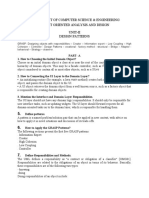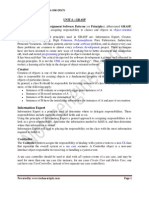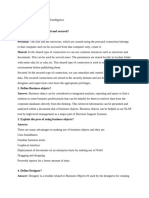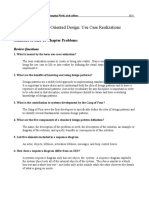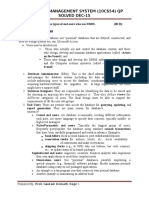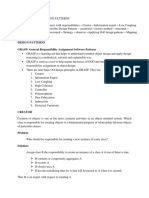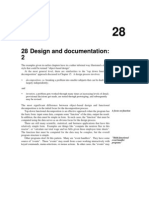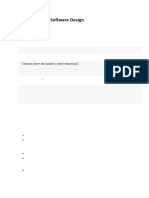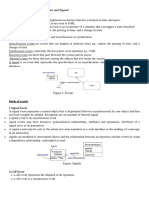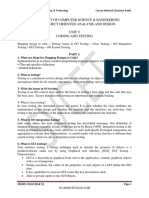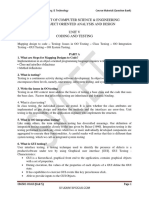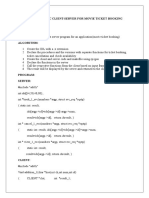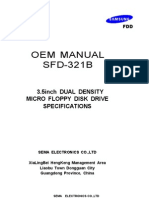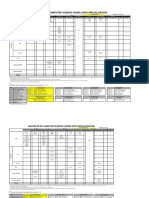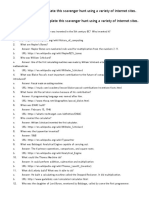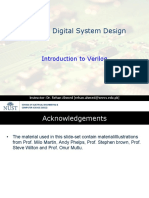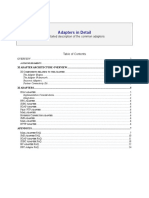Department of Computer Science & Engineering Cs6502-Object Oriented Analysis and Design Unit-Ii Design Patterns
Department of Computer Science & Engineering Cs6502-Object Oriented Analysis and Design Unit-Ii Design Patterns
Uploaded by
vijiCopyright:
Available Formats
Department of Computer Science & Engineering Cs6502-Object Oriented Analysis and Design Unit-Ii Design Patterns
Department of Computer Science & Engineering Cs6502-Object Oriented Analysis and Design Unit-Ii Design Patterns
Uploaded by
vijiOriginal Title
Copyright
Available Formats
Share this document
Did you find this document useful?
Is this content inappropriate?
Copyright:
Available Formats
Department of Computer Science & Engineering Cs6502-Object Oriented Analysis and Design Unit-Ii Design Patterns
Department of Computer Science & Engineering Cs6502-Object Oriented Analysis and Design Unit-Ii Design Patterns
Uploaded by
vijiCopyright:
Available Formats
Sri Vidya College Of Engineering & Technology Course Material (Question Bank)
DEPARTMENT OF COMPUTER SCIENCE & ENGINEERING
CS6502-OBJECT ORIENTED ANALYSIS AND DESIGN
UNIT-II
DESIGN PATTERNS
GRASP: Designing objects with responsibilities – Creator – Information expert – Low Coupling – High
Cohesion – Controller - Design Patterns – creational - factory method - structural – Bridge – Adapter -
behavioral – Strategy – observer.
PART- A
1. How to Choosing the Initial Domain Object?
Choose as an initial domain object a class at or near the root of the containment or aggregation
hierarchy of domain objects. This may be a facade controller, such as Register, or some other
object considered to contain all or most other objects, such as a Store
.
2. How to Connecting the UI Layer to the Domain Layer?
• An initializing routine (for example, a Java main method) creates both a UI and a domain
object, and passes the domain object to the UI.
• A UI object retrieves the domain object from a well-known source, such as a factory object that
is responsible for creating domain objects.
3. Mention the Interface and Domain Layer Responsibilities.
The UI layer should not have any domain logic responsibilities. It should only be responsible for
user interface tasks, such as updating widgets. The UI layer should forward requests for all
domain-oriented tasks on to the domain layer, which is responsible for handling them.
5. Define patterns.
A pattern is a named problem/solution pair that can be applied in new context, with advice on
how to apply it in novel situations and discussion of its trade-offs.
6. How to Apply the GRASP Patterns?
The following sections present the first five GRASP patterns:
. Information Expert
. Creator
. High Cohesion
. Low Coupling
. Controller
7. Define Responsibilities and Methods.
The UML defines a responsibility as "a contract or obligation of a classifier" [OMG01].
Responsibilities are related to the obligations of an object in terms of its behavior. Basically,
these responsibilities are of the following two types:
- knowing
-doing
Doing responsibilities of an object include:
CS6502-OOAD (Unit 2) Page 1
STUDENTSFOCUS.COM
Sri Vidya College Of Engineering & Technology Course Material (Question Bank)
- doing something itself, such as creating an object or doing a calculation
- initiating action in other objects
-controlling and coordinating activities in other objects
Knowing responsibilities of an object include:
- knowing about private encapsulated data
- knowing about related objects
- knowing about things it can derive or calculate
8. Who is creator?
Solution Assign class B the responsibility to create an instance of class A if one or more of the
following is true:
. B aggregates an object.
. B contains an object.
. B records instances of objects.
. B closely uses objects.
. B has the initializing data that will be passed to A when it is created (thus B is an Expert with
respect to creating A).
B is a creator of an object.
If more than one option applies, prefer a class B which aggregates or contains class A.
9. List out some scenarios that illustrate varying degrees of functional cohesion.
-Very low cohesion
-low cohesion
-High cohesion
-Moderate cohesion
10. Define Modular Design.
Coupling and cohesion are old principles in software design; designing with objects does not
imply ignoring well-established fundamentals. Another of these. Which is strongly related to
coupling and cohesion? is to promote modular design.
11. What are the advantages of Factory objects?
• Separate the responsibility of complex creation into cohesive helper objects.
• Hide potentially complex creation logic.
• Allow introduction of performance-enhancing memory management strategies, such as object
caching or recycling.
12. Designing for Non-Functional or Quality Requirements.
Interestingly—and this a key point in software architecture—it is common that the large-scale
themes, patterns, and structures of the software architecture are shaped by the designs to resolve
the non-functional or quality requirements, rather than the basic business logic.
13. Abstract for Factory (GoF) for Families of Related Objects.
The Java POS implementations will be purchased from manufacturers.
For example5:
// IBM's drivers
com.ibm.pos.jpos.CashDrawer (implements jpos.CashDrawer)
CS6502-OOAD (Unit 2) Page 2
STUDENTSFOCUS.COM
Sri Vidya College Of Engineering & Technology Course Material (Question Bank)
com.ibm.pos.jpos.CoinDispenser (implements jpos.CoinDispenser)
// NCR's drivers
com.ncr.posdrivers.CashDrawer (implements jpos.CashDrawer)
com.ncr.posdrivers.CoinDispenser (implements
jpos.CoinDispenser)
14. What is meant by Abstract Class Abstract Factory?
A common variation on Abstract Factory is to create an abstract class factory that is accessed
using the Singleton pattern, reads from a system property to decide which of its subclass
factories to create, and then returns the appropriate subclass instance. This is used, for example,
in the Java libraries with the java.awt.Toolkit class, which is an abstract class abstract factory
for creating families of GUI widgets for different operating system and GUI subsystems.
15. What is meant by Fine-Grained Classes?
Consider the creation of the Credit Card, Drivers License, and Check software objects. Our
first impulse might be to record the data they hold simply in their related payment classes, and
eliminate such fine-grained classes. However, it is usually a more profitable strategy to use them;
they often end up providing useful behavior and being reusable. For example, the Credit Card is
a natural Expert on telling you its credit company type (Visa, MasterCard, and so on). This
behavior will turn out to be necessary for our application.
16. Define coupling. APIRAL/MAY-2011
The degree to which components depend on one another. There are two types of coupling, "tight"
and "loose". Loose coupling is desirable for good software engineering but tight coupling may be
necessary for maximum performance. Coupling is increased when the data exchanged between
components becomes larger or more complex.
17. What is meant by Low Coupling?
Coupling is a measure of how strongly one element is connected to, has knowledge of, or relies
on other elements. An element with low (or weak) coupling is not dependent on too many other
elements; "too many" is context-dependent, but will be examined. These elements include
classes, subsystems, systems, and so on.
18. What is meant by High cohesion?
Cohesion (or more specifically, functional cohesion) is a measure of how strongly related and
focused the responsibilities of an element are. An element with highly related responsibilities,
and which does not do a tremendous amount of work, has high cohesion. These elements include
classes, subsystems, and so on.
19. Define Controller.
Assign the responsibility for receiving or handling a system event message to a class
representing one of the following choices:
- Represents the overall system, device, or subsystem (facade controller).
- Represents a use case scenario within which the system event occurs, often named
<UseCaseName>Handler, <UseCaseName>Coordinator, or
<Use-CaseName>Session (use-case or session controller).
CS6502-OOAD (Unit 2) Page 3
STUDENTSFOCUS.COM
Sri Vidya College Of Engineering & Technology Course Material (Question Bank)
- Use the same controller class for all system events in the same use case scenario.
-Informally, a session is an instance of a conversation with an actor.
-Sessions can be of any length, but are often organized in terms of use cases (use case sessions).
PART- B
1. Explain Grasp: designing objects with responsibilities.
-Responsibilities and Methods
-Responsibilities and Interaction Diagrams
-Patterns
2. Explain GRASP: Patterns of General Principles in Assigning Responsibilities. APIRL/MAY-
2011
-The UML Class Diagram Notation
-Information Expert (or Expert)
-Creator
-low coupling
-high cohesion
-controller
-object design and CRC CARDS
3. How to Determining the Visibility of the Design Model?
-Visibility between Objects
-Visibility
4. Explain about Patterns for Assigning Responsibilities.
-Polymorphism
-Pure Fabrication
-Indirection
-Protected Variations
5. Designing the Use-Case Realizations with GoF Design Patterns. APRIL/MAY-2011
-Analysis" Discoveries during Design: Domain Model
-Factory
-Singleton
-Conclusion of the External Services with Varying Interfaces Problem 3
-Strategy
-Composite
-Facade
CS6502-OOAD (Unit 2) Page 4
STUDENTSFOCUS.COM
You might also like
- Department of Computer Science & Engineering Object Oriented Analysis and Design Unit-Ii Design PatternsDocument4 pagesDepartment of Computer Science & Engineering Object Oriented Analysis and Design Unit-Ii Design Patternsviswanath kaniNo ratings yet
- GRASP - General Responsibility Assignment Software Patterns (Or Principles)Document1 pageGRASP - General Responsibility Assignment Software Patterns (Or Principles)MJ KhanNo ratings yet
- OOAD Lab3Document15 pagesOOAD Lab3Atul ShadyNo ratings yet
- Department of Computer Science & Engineering Cs6502-Object Oriented Analysis and Design Unit Iv Applying Design PatternsDocument3 pagesDepartment of Computer Science & Engineering Cs6502-Object Oriented Analysis and Design Unit Iv Applying Design PatternsvijiNo ratings yet
- Ooad Question BankDocument23 pagesOoad Question BankPushpavalli MohanNo ratings yet
- Question Bank - 2013 - Regulation PDFDocument14 pagesQuestion Bank - 2013 - Regulation PDFRevathi SaravananNo ratings yet
- 2marks Ooad Notes Revised1Document35 pages2marks Ooad Notes Revised1sagayadesdemonaNo ratings yet
- SNS College of Technology: Object Oriented System DesignDocument22 pagesSNS College of Technology: Object Oriented System DesignJennifer CarpenterNo ratings yet
- OOAD Complete Notes 1 5Document101 pagesOOAD Complete Notes 1 5Aravinthan RockzzNo ratings yet
- Q1) What Is The % of BA in Team Size and Project Duration?Document13 pagesQ1) What Is The % of BA in Team Size and Project Duration?SURAJ RATHODNo ratings yet
- Department of Computer Applications (M.C.A.) Object Oriented Analysis and Design Two - Marks Questions & AnswersDocument11 pagesDepartment of Computer Applications (M.C.A.) Object Oriented Analysis and Design Two - Marks Questions & AnswersanithashankarNo ratings yet
- OODM 1 (Part 1)Document31 pagesOODM 1 (Part 1)sachinch01432No ratings yet
- Ooad UNIT 4 NotesDocument11 pagesOoad UNIT 4 Notesplutopop50% (2)
- Software Architecture PatternsDocument55 pagesSoftware Architecture Patternseggie545100% (15)
- Unit 3 Ooad 2020Document43 pagesUnit 3 Ooad 2020LAVANYA KARTHIKEYANNo ratings yet
- Lab&Assignment07 ClassDesignDocument21 pagesLab&Assignment07 ClassDesignDuy Nguyen HuuNo ratings yet
- OOAD Sample PaperDocument23 pagesOOAD Sample PaperHassan Bin RaeesNo ratings yet
- Ooad Question BankDocument21 pagesOoad Question BankDhilip PrabakaranNo ratings yet
- Software Architecture PatternsDocument55 pagesSoftware Architecture PatternsAnyul Rivas100% (1)
- Ooad 2 MarksDocument16 pagesOoad 2 MarksMANIKANDAN BNo ratings yet
- SAP Business Objects Web IntelligenceDocument9 pagesSAP Business Objects Web Intelligence97911No ratings yet
- ISD LAB06-ClassDesignDocument11 pagesISD LAB06-ClassDesignTú PhạmNo ratings yet
- # SoftwareArchitectureandSoftwareDesignDocument4 pages# SoftwareArchitectureandSoftwareDesignalejandro obregonNo ratings yet
- Ooad U2 KeyDocument67 pagesOoad U2 KeyWAR THANESHNo ratings yet
- Department of Computer Science & Engineering Cs6502-Object Oriented Analysis and Design Unit Iii Case StudyDocument4 pagesDepartment of Computer Science & Engineering Cs6502-Object Oriented Analysis and Design Unit Iii Case StudyvijiNo ratings yet
- EC2202-question BankDocument24 pagesEC2202-question BankAnirudhan RaviNo ratings yet
- IOS Developer - Experienced Interview QA'sDocument84 pagesIOS Developer - Experienced Interview QA'sswornavidhya.mahadevanNo ratings yet
- Cs1402 Ooad 2 MarksDocument39 pagesCs1402 Ooad 2 MarksPavithra SivarajaNo ratings yet
- Digital Hardware Design An Object-Oriented Approach: By: Tarak G. Modi Advisor: Dr. WellsDocument5 pagesDigital Hardware Design An Object-Oriented Approach: By: Tarak G. Modi Advisor: Dr. WellsAbhinav GageNo ratings yet
- 6ed Solutions Chap11Document52 pages6ed Solutions Chap11JesseSpero100% (3)
- Unit 1Document54 pagesUnit 1Pushpavalli MohanNo ratings yet
- OOAD 2marksDocument35 pagesOOAD 2marksRamya SivaramanNo ratings yet
- ISD LAB10-DesignConceptsDocument6 pagesISD LAB10-DesignConceptsTú PhạmNo ratings yet
- Dbms QP-15Document22 pagesDbms QP-15Gautam DemattiNo ratings yet
- CPP Final Feb2020Document77 pagesCPP Final Feb2020nikita thombreNo ratings yet
- Ooad Unit IVDocument14 pagesOoad Unit IVS DivyaNo ratings yet
- 28 Design and Documentation: 2: Decomposition, I.E. Breaking A Problem Into Smaller Subparts That Can Be Dealt WithDocument8 pages28 Design and Documentation: 2: Decomposition, I.E. Breaking A Problem Into Smaller Subparts That Can Be Dealt Withapi-3745065No ratings yet
- Pocket Campus Tour: Architecture/Design DocumentDocument12 pagesPocket Campus Tour: Architecture/Design Documentمیلاد نادریNo ratings yet
- Excercise 08: Đại Học Quốc Gia Thành Phố Hồ Chí Minh Trường Đại Học Khoa Học Tự Nhiên Khoa Công Nghệ Thông TinDocument22 pagesExcercise 08: Đại Học Quốc Gia Thành Phố Hồ Chí Minh Trường Đại Học Khoa Học Tự Nhiên Khoa Công Nghệ Thông TinNgọc Lê HoàngNo ratings yet
- Object Oriented Analysis and Design Important QuestionsDocument24 pagesObject Oriented Analysis and Design Important QuestionsHarini RagavendranNo ratings yet
- SAP Business Objects Web Intelligence1Document11 pagesSAP Business Objects Web Intelligence197911No ratings yet
- Basics: Architecture, Guardials, Inheritance, Methodology, Classes 6'RsDocument27 pagesBasics: Architecture, Guardials, Inheritance, Methodology, Classes 6'RsKishore Velakaturi100% (1)
- Gagan Ooad FileDocument58 pagesGagan Ooad Filepagal paneNo ratings yet
- Experiment 1: Aim: Prepare A SRS Document in Line With IEEE Recommended Standards ofDocument32 pagesExperiment 1: Aim: Prepare A SRS Document in Line With IEEE Recommended Standards ofNishant MishraNo ratings yet
- SE Unit 2 QB & AK FullDocument12 pagesSE Unit 2 QB & AK FullSathishkumar MNo ratings yet
- Scsa1401 - Ooase - Unit 4Document51 pagesScsa1401 - Ooase - Unit 4G.AkshayaNo ratings yet
- Assignment03 ClassDesignDocument11 pagesAssignment03 ClassDesignHoài LinhNo ratings yet
- OOAD All Chapter NOTES - 20211218132503Document79 pagesOOAD All Chapter NOTES - 20211218132503Sushan KawanNo ratings yet
- Unit-3 PPT NotesDocument69 pagesUnit-3 PPT NotesBruce WayneNo ratings yet
- The Object-Oriented Thought ProcessDocument19 pagesThe Object-Oriented Thought ProcessRonaldNo ratings yet
- A4 MAD Fall23 19122023 020713pmDocument9 pagesA4 MAD Fall23 19122023 020713pmAthar IslamNo ratings yet
- Marks: 50 Comments: GoodDocument9 pagesMarks: 50 Comments: GoodSahar RazaNo ratings yet
- Object Oriented Pro Cplusplus E3Document6 pagesObject Oriented Pro Cplusplus E3priya h.pNo ratings yet
- TOPIC2Document8 pagesTOPIC2Nagar JagdishNo ratings yet
- BO (Business Object inDocument25 pagesBO (Business Object inKamlesh RajputNo ratings yet
- Acsse Ifm01b1 2024 L02Document22 pagesAcsse Ifm01b1 2024 L02lindokuhl31509No ratings yet
- Introduction to Reliable and Secure Distributed ProgrammingFrom EverandIntroduction to Reliable and Secure Distributed ProgrammingNo ratings yet
- Software Design for Flexibility: How to Avoid Programming Yourself into a CornerFrom EverandSoftware Design for Flexibility: How to Avoid Programming Yourself into a CornerNo ratings yet
- Events and SignalsDocument17 pagesEvents and SignalsvijiNo ratings yet
- P.G Department of Computer Applications 19Pmc320 Ooad & Uml K1 Level QuestionsDocument19 pagesP.G Department of Computer Applications 19Pmc320 Ooad & Uml K1 Level QuestionsvijiNo ratings yet
- QB104535 PDFDocument2 pagesQB104535 PDFvijiNo ratings yet
- QB104535 PDFDocument2 pagesQB104535 PDFvijiNo ratings yet
- Department of Computer Science & Engineering Cs6502-Object Oriented Analysis and Design Unit V Coding and TestingDocument2 pagesDepartment of Computer Science & Engineering Cs6502-Object Oriented Analysis and Design Unit V Coding and TestingvijiNo ratings yet
- Department of Computer Science & Engineering Cs6502-Object Oriented Analysis and Design Unit Iii Case StudyDocument4 pagesDepartment of Computer Science & Engineering Cs6502-Object Oriented Analysis and Design Unit Iii Case StudyvijiNo ratings yet
- C QuesDocument4 pagesC QuesvijiNo ratings yet
- Dahua HTTP API For Ipc v1.67Document126 pagesDahua HTTP API For Ipc v1.67Zain AliNo ratings yet
- Hill CH 2 Ed 3Document61 pagesHill CH 2 Ed 3Tamiru HailuNo ratings yet
- Temenos Marketplace Product Certification GuidanceDocument11 pagesTemenos Marketplace Product Certification GuidanceMohamed Amin MessaoudNo ratings yet
- PBC Computer Books-ScDocument37 pagesPBC Computer Books-ScWaris ArslanNo ratings yet
- 6 - Cyber Physical Systems PDFDocument21 pages6 - Cyber Physical Systems PDFNIKHIL ARORANo ratings yet
- Sharper Optics For Sharper Meetings.: Logitech PTZ Pro 2Document2 pagesSharper Optics For Sharper Meetings.: Logitech PTZ Pro 2Indonesia RayaNo ratings yet
- HP Company Laptop Survey TopicDocument3 pagesHP Company Laptop Survey TopicShaikh AsifNo ratings yet
- RPC Client Server For Movie Ticket BookingDocument3 pagesRPC Client Server For Movie Ticket Bookingsaranya n rNo ratings yet
- Hyperledger Bootcamp Moscow - Building Your First Identity ApplicationDocument21 pagesHyperledger Bootcamp Moscow - Building Your First Identity ApplicationVitalNo ratings yet
- Samsung SFD321B 070103Document31 pagesSamsung SFD321B 070103Joshua Castro RiveraNo ratings yet
- Student Management System: Java Mini Project ReportDocument44 pagesStudent Management System: Java Mini Project ReportLogeshwaran MuruganNo ratings yet
- Computer Architecture PDFDocument18 pagesComputer Architecture PDFMuhammad Mehroz BadshahNo ratings yet
- CV NijkampDocument2 pagesCV NijkamperiknijkampNo ratings yet
- Backup Exec Deduplication Option's Deduplication Engine (Spoold) Fails To Start Due To Files Deleted - Quarantined by Antivirus SoftwareDocument3 pagesBackup Exec Deduplication Option's Deduplication Engine (Spoold) Fails To Start Due To Files Deleted - Quarantined by Antivirus SoftwareMario TabuadaNo ratings yet
- System Galaxy Quick Guide: Configuration and OperationDocument47 pagesSystem Galaxy Quick Guide: Configuration and OperationMD Omar FarukNo ratings yet
- Settings IIS 7 Vs Domino 851Document6 pagesSettings IIS 7 Vs Domino 851ptrroNo ratings yet
- Online Book Store by Vamsi Krishna Mummaneni: Kansas State University Manhattan KansasDocument76 pagesOnline Book Store by Vamsi Krishna Mummaneni: Kansas State University Manhattan Kansasali mohamedNo ratings yet
- Electron Docs Gitbook enDocument217 pagesElectron Docs Gitbook enRichard M ShawNo ratings yet
- Email Retention PolicyDocument39 pagesEmail Retention PolicyPeter SimonNo ratings yet
- New 12345676543Document6 pagesNew 12345676543Matthew MathewsNo ratings yet
- Consult IT - Global Consulting: Web Tech TalksDocument34 pagesConsult IT - Global Consulting: Web Tech TalksFormat_C100% (1)
- Bachelor of Computer Science (Hons) (With Specialization)Document3 pagesBachelor of Computer Science (Hons) (With Specialization)JakeBondNo ratings yet
- Basics Configuration of PBX Nortel Meridain 81cDocument26 pagesBasics Configuration of PBX Nortel Meridain 81cGil HaleNo ratings yet
- Wasthu Vidyawe Mulika Anga - MAHESH CHATHURANGADocument1 pageWasthu Vidyawe Mulika Anga - MAHESH CHATHURANGASECS TECHNo ratings yet
- RF-ID Based Touch Screen Museum Guide System: Mr.L.R.Patil, Mr.H.T.Ingale, Dr.K.P.Rane Mrs.S.K.ChaudhariDocument5 pagesRF-ID Based Touch Screen Museum Guide System: Mr.L.R.Patil, Mr.H.T.Ingale, Dr.K.P.Rane Mrs.S.K.ChaudharitheijesNo ratings yet
- Computer Science History Scavenger Hunt Answer KeyDocument4 pagesComputer Science History Scavenger Hunt Answer KeyStephen Mack100% (1)
- L02 - Introduction To VerilogDocument17 pagesL02 - Introduction To VerilogAlinaNo ratings yet
- Adapters in DetailDocument27 pagesAdapters in DetailDileep Kumar Naidu RayalaNo ratings yet
- Unit 102 CanonDocument2 pagesUnit 102 CanonSanjay ArmarkarNo ratings yet
- Nasir CV in PDFDocument2 pagesNasir CV in PDFAsim AliNo ratings yet
